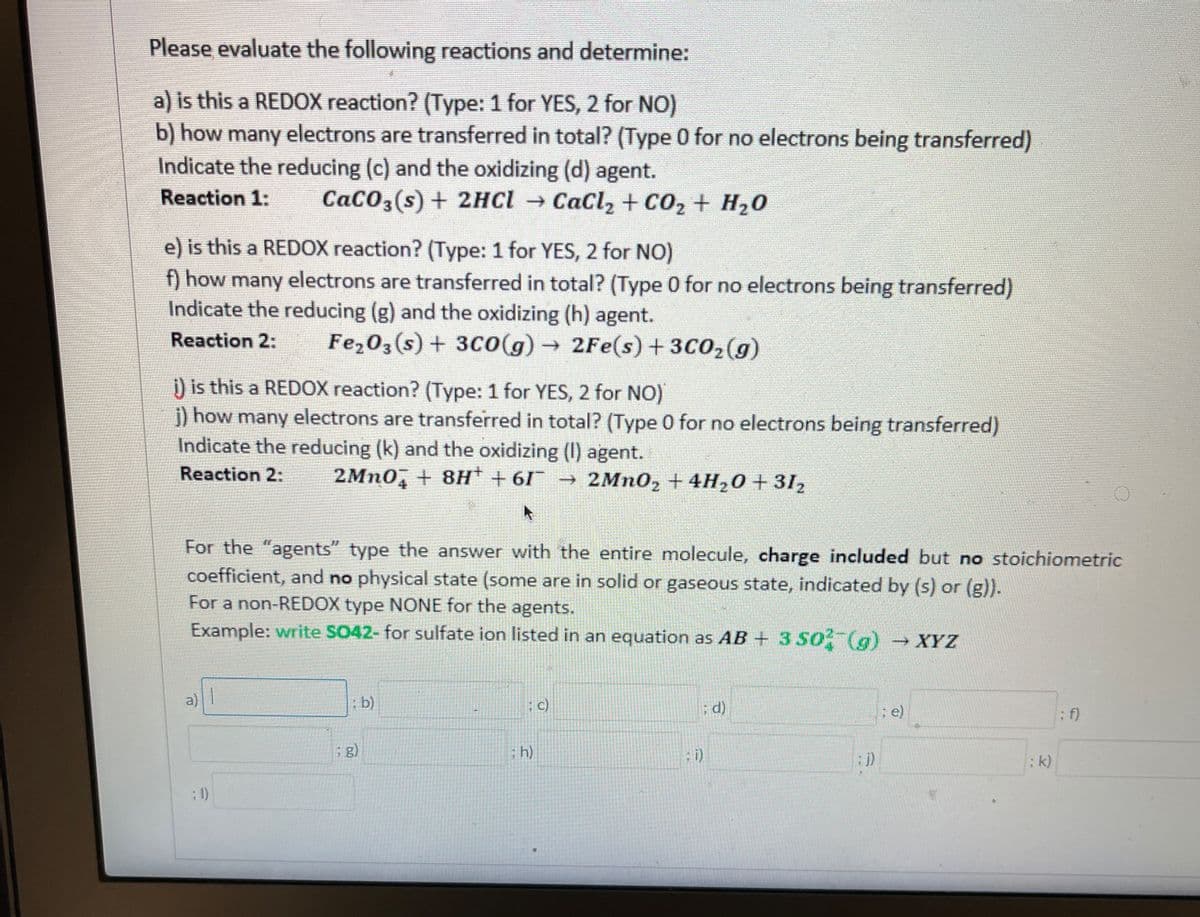Please evaluate the following reactions and determine: a) is this a REDOX reaction? (Type: 1 for YES, 2 for NO) b) how many electrons are transferred in total? (Type 0 for no electrons being transferred) Indicate the reducing (c) and the oxidizing (d) agent. Reaction 1: CaCO3(s) + 2HCl → CaCl, + C02 + H20 e) is this a REDOX reaction? (Type: 1 for YES, 2 for NO) f) how many electrons are transferred in total? (Type 0 for no electrons being transferred) Indicate the reducing (g) and the oxidizing (h) agent. Reaction 2: Fe,03(s) + 3C0(g) → 2Fe(s)+3CO2(g) i) is this a REDOX reaction? (Type: 1 for YES, 2 for NO) j) how many electrons are transferred in total? (Type 0 for no electrons being transferred) Indicate the reducing (k) and the oxidizing (I) agent. Reaction 2: 2Mn0, + 8H + 61 → 2Mn02 + 4H20 + 3. For the "agents" type the answer with the entire molecule, charge included but no stoichiometric coefficient, and no physical state (some are in solid or gaseous state, indicated by (s) or (g)). For a non-REDOX type NONE for the agents. Example: write SO42- for sulfate ion listed in an equation as AB + 3 S0 (g) - XYZ a) : b) d) ; e) :f) h) i) ; k)
Please evaluate the following reactions and determine: a) is this a REDOX reaction? (Type: 1 for YES, 2 for NO) b) how many electrons are transferred in total? (Type 0 for no electrons being transferred) Indicate the reducing (c) and the oxidizing (d) agent. Reaction 1: CaCO3(s) + 2HCl → CaCl, + C02 + H20 e) is this a REDOX reaction? (Type: 1 for YES, 2 for NO) f) how many electrons are transferred in total? (Type 0 for no electrons being transferred) Indicate the reducing (g) and the oxidizing (h) agent. Reaction 2: Fe,03(s) + 3C0(g) → 2Fe(s)+3CO2(g) i) is this a REDOX reaction? (Type: 1 for YES, 2 for NO) j) how many electrons are transferred in total? (Type 0 for no electrons being transferred) Indicate the reducing (k) and the oxidizing (I) agent. Reaction 2: 2Mn0, + 8H + 61 → 2Mn02 + 4H20 + 3. For the "agents" type the answer with the entire molecule, charge included but no stoichiometric coefficient, and no physical state (some are in solid or gaseous state, indicated by (s) or (g)). For a non-REDOX type NONE for the agents. Example: write SO42- for sulfate ion listed in an equation as AB + 3 S0 (g) - XYZ a) : b) d) ; e) :f) h) i) ; k)
Chemistry: Principles and Reactions
8th Edition
ISBN:9781305079373
Author:William L. Masterton, Cecile N. Hurley
Publisher:William L. Masterton, Cecile N. Hurley
Chapter4: Reactions In Aqueous Solution
Section: Chapter Questions
Problem 58QAP: The iron content of hemoglobin is determined by destroying the hemoglobin molecule and producing...
Related questions
Question

Transcribed Image Text:Please evaluate the following reactions and determine:
a) is this a RED0X reaction? (Type: 1 for YES, 2 for NO)
b) how many electrons are transferred in total? (Type 0 for no electrons being transferred)
Indicate the reducing (c) and the oxidizing (d) agent.
Reaction 1:
CaCO3 (s) + 2HCI CaCl2 + CO2 + H20
e) is this a REDOX reaction? (Type: 1 for YES, 2 for NO)
f) how many electrons are transferred in total? (Type 0 for no electrons being transferred)
Indicate the reducing (g) and the oxidizing (h) agent.
Reaction 2:
Fe,03(s) + 3C0(g) 2Fe(s)+ 3CO2(g)
i) is this a REDOX reaction? (Type: 1 for YES, 2 for NO)
i) how many electrons are transferred in total? (Type 0 for no electrons being transferred)
Indicate the reducing (k) and the oxidizing (I) agent.
Reaction 2:
2Mn0, + 8H + 61 → 2MN02 + 4H20 + 312
For the "agents" type the answer with the entire molecule, charge included but no stoichiometric
coefficient, and no physical state (some are in solid or gaseous state, indicated by (s) or (g)).
For a non-REDOX type NONE for the agents.
Example: write S042- for sulfate ion listed in an equation as AB + 3 S0(g) →XYZ
a)
; b)
:c)
d)
; e)
; f)
:h)
i)
; k)
; 1)
Expert Solution
This question has been solved!
Explore an expertly crafted, step-by-step solution for a thorough understanding of key concepts.
This is a popular solution!
Trending now
This is a popular solution!
Step by step
Solved in 3 steps

Knowledge Booster
Learn more about
Need a deep-dive on the concept behind this application? Look no further. Learn more about this topic, chemistry and related others by exploring similar questions and additional content below.Recommended textbooks for you

Chemistry: Principles and Reactions
Chemistry
ISBN:
9781305079373
Author:
William L. Masterton, Cecile N. Hurley
Publisher:
Cengage Learning

Chemistry: Matter and Change
Chemistry
ISBN:
9780078746376
Author:
Dinah Zike, Laurel Dingrando, Nicholas Hainen, Cheryl Wistrom
Publisher:
Glencoe/McGraw-Hill School Pub Co

General Chemistry - Standalone book (MindTap Cour…
Chemistry
ISBN:
9781305580343
Author:
Steven D. Gammon, Ebbing, Darrell Ebbing, Steven D., Darrell; Gammon, Darrell Ebbing; Steven D. Gammon, Darrell D.; Gammon, Ebbing; Steven D. Gammon; Darrell
Publisher:
Cengage Learning

Chemistry: Principles and Reactions
Chemistry
ISBN:
9781305079373
Author:
William L. Masterton, Cecile N. Hurley
Publisher:
Cengage Learning

Chemistry: Matter and Change
Chemistry
ISBN:
9780078746376
Author:
Dinah Zike, Laurel Dingrando, Nicholas Hainen, Cheryl Wistrom
Publisher:
Glencoe/McGraw-Hill School Pub Co

General Chemistry - Standalone book (MindTap Cour…
Chemistry
ISBN:
9781305580343
Author:
Steven D. Gammon, Ebbing, Darrell Ebbing, Steven D., Darrell; Gammon, Darrell Ebbing; Steven D. Gammon, Darrell D.; Gammon, Ebbing; Steven D. Gammon; Darrell
Publisher:
Cengage Learning

Introductory Chemistry: A Foundation
Chemistry
ISBN:
9781337399425
Author:
Steven S. Zumdahl, Donald J. DeCoste
Publisher:
Cengage Learning

Chemistry: Principles and Practice
Chemistry
ISBN:
9780534420123
Author:
Daniel L. Reger, Scott R. Goode, David W. Ball, Edward Mercer
Publisher:
Cengage Learning

Chemistry & Chemical Reactivity
Chemistry
ISBN:
9781133949640
Author:
John C. Kotz, Paul M. Treichel, John Townsend, David Treichel
Publisher:
Cengage Learning